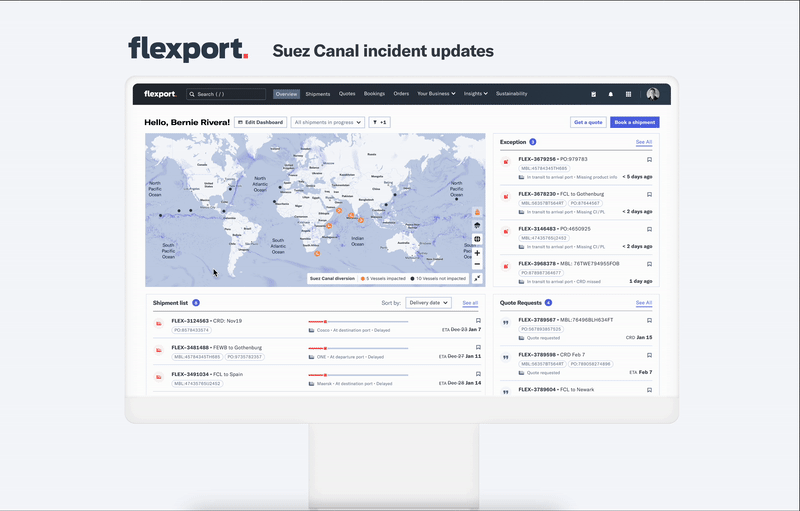
December 21, 2023
Logistics Rewired Webinar Recap: Navigating the Suez Canal Situation
Logistics Rewired Webinar Recap: Navigating the Suez Canal Situation

December 21, 2023
Recent drone and missile attacks on commercial ships, including container ships in the Red Sea and Bab-el-Mandeb strait, have prompted global ocean carriers to take precautions to protect the safety of crew members.
The strikes are targeting one of the world's busiest routes for fuel and container shipments, impacting the Bab-el-Mandeb strait, which is crucial for vessels traveling to and from the Suez Canal. All major ocean carriers have advised they will pause or divert vessels headed toward the Suez Canal.
On December 20, 2023, industry experts from Flexport came together on a webinar with Lars Jensen, CEO and Partner of Vespucci Maritime, to discuss current updates to the Suez Canal situation and what shippers can do to navigate the waters.
Below are the top three highlights shared:
1. Drought and missile attacks have hindered the world’s two most important shipping canals
The ongoing Israel-Hamas & Yemen Conflict, coupled with an ongoing drought in the Panama Canal, has brought severe stress onto the major choke points of shipping routes.
The Panama Canal makes up 8% of global cargo transits (excluding Intra-Asia) and drought conditions have led to slot and weight restrictions and diversions to the Suez Canal. However, with the recent vessel attacks on ships traveling through the Suez Canal, all major container carriers are being forced to divert vessels to the Cape of Good Hope instead. Despite being able to sail at higher speeds around the Cape of Good Hope, sailing around South Africa frequently presents windy conditions and congestion that may force vessels to slow down.
2. Carriers are facing transit time extensions as vessels are being re-routed via the Cape of Good Hope
As of December 20, carriers have diverted 170 vessels south of Africa and about 35 have paused their journey altogether. This is causing major delays for most current shipments, but transit time extensions are even more extreme for vessels already in the Mediterranean, the Gulf of Aden, and vessels previously diverted from the Panama Canal bound for the U.S. East Coast. Future departures are also expected to face longer transit times for routes between Asia and Europe and Asia and the U.S. East Coast.
3. There are still significant unknowns in the situation
Despite a lot of new information released each day regarding the current Suez Canal situation, there are still several unknowns, including but not limited to:
- How long the situation will last
- Future force majeure declarations
- Equipment imbalance extremity
- Multinational military security plan
- Future Panama Canal rainfall
This Suez Canal situation directly coincides with the Lunar New Year peak, which means that we are going to see a tighter supply and demand balance than what we've seen this year. But with the potential for demand to surpass effective capacity before the Lunar New Year, the key question becomes ‘What will demand look like after mid-February?’
What Shippers Can Do to Navigate These Waters
While there are a few reactionary steps you can take to prepare your future supply chain, such as incorporating additional lead time into inventory planning, booking cargo 4-6 weeks before planned departure to secure capacity, or using premium services like space guarantees or expedited services, the best approach is to talk directly to your logistics provider.
Flexport helps customers stay in control of their shipments directly in the Flexport Platform with real-time updates on individual shipments via our new Suez Canal visibility feature. To learn more about this interactive map, watch the ‘Logistics Rewired: Navigating the Suez Canal Fallout’ webinar on demand here.



The contents of this blog are made available for informational purposes only and should not be relied upon for any legal, business, or financial decisions. We do not guarantee, represent, or warrant the accuracy or reliability of any of the contents of this blog because they are based on Flexport’s current beliefs, expectations, and assumptions, about which there can be no assurance due to various anticipated and unanticipated events that may occur. This blog has been prepared to the best of Flexport’s knowledge and research; however, the information presented in this blog herein may not reflect the most current regulatory or industry developments. Neither Flexport nor its advisors or affiliates shall be liable for any losses that arise in any way due to the reliance on the contents contained in this blog.
About the Author

December 21, 2023


